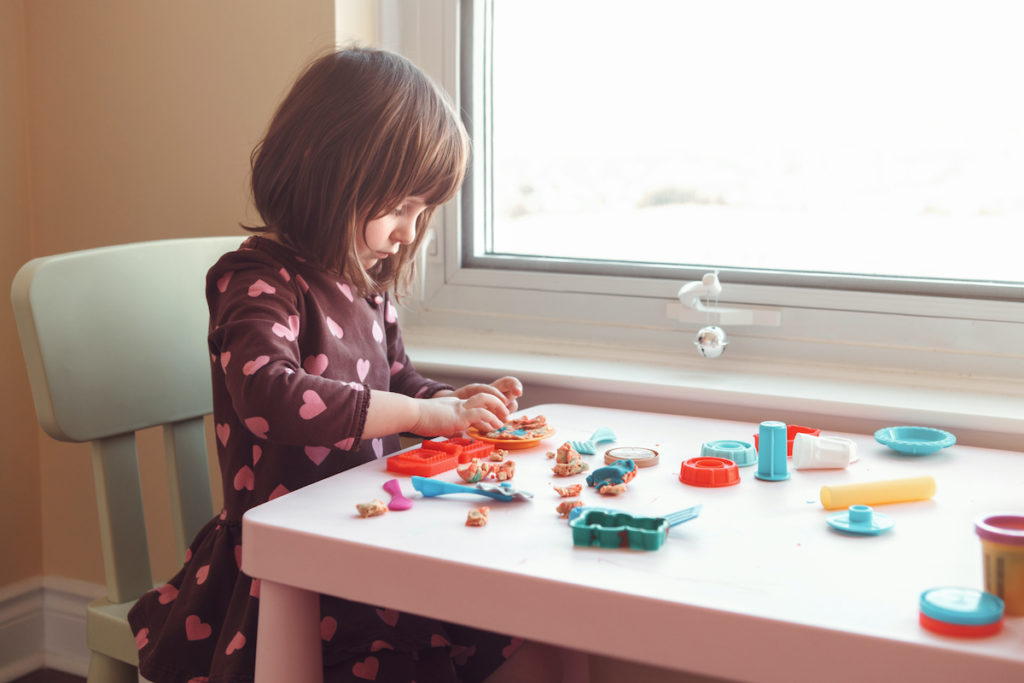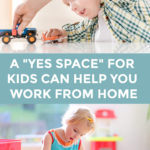How a Yes Space Can Help You Get More Done Without Childcare
For parents who find themselves with the difficult task of working from home with kids (and guiding homeschool), creating a Yes Space for kids can help those long days run a little more smoothly.

Shortly after leaving the corporate world to stay home with our two boys, I transitioned into a freelance writing career. My earliest memory of the challenges that come with working from home with small children involves the game my kindergartener called “bowling with apples”.
It sounds like a cute game. And in fact it might have been, had he and his toddler brother not eaten the skin off the apples and tried to use our two black and white cats as the bowling pins.
That was the day I learned the truth of the phrase,“Silence is golden… unless you have a toddler.”
Cleaning up juicy apple pieces mixed with cat hair and sticky little hands is decidedly NOT golden when you have a major deadline looming. Side note – once you get the sticky part up, apple juice leaves hardwood floors quite shiny.
Those little guys are teens now, and thankfully very self-sufficient these days. But as our readers tell us about the challenges they’re facing working from home without childcare during these anxiety-ridden times, it’s very easy for me to connect with the feelings of overwhelm I had back then.
The Challenge of Working from Home with Kids
There are so many different versions of how this quarantine is affecting families, but for parents who find themselves with the difficult task of working full-time while parenting full-time (and guiding homeschool), the best thing you can do is give yourself grace.
I spoke with peaceful parenting expert Dr. Laura Markham to get advice on how parents can navigate this situation. And as we shared parenting adventures, she encouraged me to tell the apple bowling story. “It wasn’t a tragedy,” she observed. “Parents need permission to not be perfect right now. They can find humor in the mishaps. And there will be some mishaps.”
Creating a Yes Space for Your Child
Because babies and toddlers so often hear “no no,” or, “don’t touch,” respectful parenting expert Janet Lansbury advises parents to create a Yes Space, or a safe area for little ones to explore and play without your constant intervention.
Under normal circumstances, you might be surprised at how long little ones (even babies) can play on their own once parents stop being their full time entertainer or rule enforcer. Of course, with so much uncertainty right now, it’s natural for kids – especially sensitive children – to pick up on the fear-based energy and need their parents more.
Enter the solution of a Yes Space. “During the day, a small child will be in the same main areas of the house as the parent,” Dr. Markham explains. Children need a place to play that is:
- Near you
- Safe (child-proofed and secure)
- Organized (so they can see what they need, clear bins of toys grouped by category)
Even from an early age, you can empower your child to take ownership of this Yes Space. As you help them keep it clean and organized, Dr. Markham says you teach your child the habit of cleaning up an area before moving on to the next activity like lunch or a nap.
Messy Play Can Be Soothing
“When my daughter was a toddler, I gave her a cookie sheet tray for play-dough, glitter, or other messy play items,” Dr. Markham shares. “We didn’t have a big house. The playroom was just a shelf of toys in the dining room near the kitchen. She knew to get out one thing at a time, and I would watch her from the kitchen. She would play for long stretches of time, and she knew when she was finished she had to clean up and get mom’s approval.”
Right now with the pandemic, Dr. Markham said she’s encouraging messy play because it’s soothing. Clay, shave cream, or sand are all things kids can manipulate with their hands. You can set up a safe outdoor place and work from a patio or deck while your child plays with a sand or water station. Even very young children can easily entertain themselves for an hour this way.
“You can also add clay to your child’s virtual playdates. Both children could be making dinosaurs to show each other and make sound effects. Meanwhile there’s the calming aspect of forming the clay in their hands.”
You May Need More Than One Yes Space
Because we all have far fewer outings right now, you may want to set up more than one Yes Space around the house. It can offer you and your child a welcome change of scenery. Think of other areas in your home that can serve as a yes space for particular activities.
Consider a Calming Corner
Another way to decrease anxiety is to create a calm down corner at home. This is a place your child can go when they need a break. It’s not a punishment or time out, it is simply a comforting place where people in your home go to settle.
Choose a quiet corner and add some comforting items like a stuffed bean bag chair or rocker. Have your child help add elements they find soothing. Dr. Markham recommends your corner include:
- A photo of your family
- Stuffed animals
- Books about emotions
- Soothing music or a guided meditation
- Calming scents (a lavender sachet)
- Something to write or draw with
Turn Off the TV
And make sure you’re keeping yourself calm. One of the most impactful ways to do this is limit your news consumption. You won’t miss anything important. Believe me, I’ve tried to completely opt out of news, and it still finds its way to me!
But lately I’ve noticed a pattern in Instagram Stories. I watch my friends’ adorable kids doing adorable things to the tune of background noise of people arguing or spouting alarming pandemic statistics. If I can hear it through the video, so can the kids in the same room with it.
I asked Dr. Markham her opinion on this background noise for kids and she candidly said, “I can’t imagine how people think it’s ok to have the news on with their child in hearing distance. The child is going to be super anxious. I recommend parents read just enough to stay informed. Don’t expose yourself to things that will heighten your anxiety.”
Cultivating a Yes Attitude
During times like these, Dr. Markham suggests we go beyond creating yes spaces and try to cultivate an overall yes attitude. “That doesn’t mean it’s a free-for-all and the child is able to do anything they want.” It means we make sure their needs are met in a loving, compassionate way. even if it isn’t in the exact way the child hopes.
Find a way to say YES instead of NO even while you set your limit. “YES, it’s time to clean up, and YES, I will help you. YES, if we hurry we can read an extra story, and YES, we can make this fun!”

